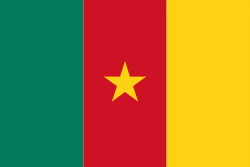Mbengwi
Mbengwi is the headquarters of Momo Department in the Northwest Region of Cameroon, located some 22 km from Bamenda.
The indigenous people are Meta people, to whom a few settlers from neighboring tribes like Ngie and Oshie have been added (see references to Dillon's work). The name "Mbengwi" means "a land of wild animals" in the Meta language since it used to be a hunting ground in the precolonial days, though it was settled before it became upgraded to an administrative centre. Today, this is still the principal function of the town whose growth has stagnated because of youth exodus and lack of income generating activities -both in the town and its hinterland.Interesting sites in include the Abi waterfalls in the heart of town and the Catholic monastery.Ecological attractions include wildlife watching (especially birds) and fishing in the Abi and Mezam Rivers.For people with anthropological interests, the 30 or so Fon's palaces (centers of traditional rule)offer an artistic wealth that is the envy of any Museum on African Art (especially woodwork) with artifacts dating back more than 300 years. For the culturally minded, the annual MECUDA (Meta Elites Cultural and Development Association)organised dance competition are also a must see. It usually comes up between December and March and offers the opportunity for this people to showcase a cultural heritage of more than 50 traditional dances.Sometimes plays and competitions in sports and other activities are organized (including agric shows).
The indigenous people are Meta people, to whom a few settlers from neighboring tribes like Ngie and Oshie have been added (see references to Dillon's work). The name "Mbengwi" means "a land of wild animals" in the Meta language since it used to be a hunting ground in the precolonial days, though it was settled before it became upgraded to an administrative centre. Today, this is still the principal function of the town whose growth has stagnated because of youth exodus and lack of income generating activities -both in the town and its hinterland.Interesting sites in include the Abi waterfalls in the heart of town and the Catholic monastery.Ecological attractions include wildlife watching (especially birds) and fishing in the Abi and Mezam Rivers.For people with anthropological interests, the 30 or so Fon's palaces (centers of traditional rule)offer an artistic wealth that is the envy of any Museum on African Art (especially woodwork) with artifacts dating back more than 300 years. For the culturally minded, the annual MECUDA (Meta Elites Cultural and Development Association)organised dance competition are also a must see. It usually comes up between December and March and offers the opportunity for this people to showcase a cultural heritage of more than 50 traditional dances.Sometimes plays and competitions in sports and other activities are organized (including agric shows).
Map - Mbengwi
Map
Country - Cameroon
 |
 |
| Flag of Cameroon | |
Early inhabitants of the territory included the Sao civilisation around Lake Chad, and the Baka hunter-gatherers in the southeastern rainforest. Portuguese explorers reached the coast in the 15th century and named the area Rio dos Camarões (Shrimp River), which became Cameroon in English. Fulani soldiers founded the Adamawa Emirate in the north in the 19th century, and various ethnic groups of the west and northwest established powerful chiefdoms and fondoms. Cameroon became a German colony in 1884 known as Kamerun. After World War I, it was divided between France and the United Kingdom as League of Nations mandates. The Union des Populations du Cameroun (UPC) political party advocated independence, but was outlawed by France in the 1950s, leading to the national liberation insurgency fought between French and UPC militant forces until early 1971. In 1960, the French-administered part of Cameroon became independent, as the Republic of Cameroun, under President Ahmadou Ahidjo. The southern part of British Cameroons federated with it in 1961 to form the Federal Republic of Cameroon. The federation was abandoned in 1972. The country was renamed the United Republic of Cameroon in 1972 and back to the Republic of Cameroon in 1984 by a presidential decree by president Paul Biya. Paul Biya, the incumbent president, has led the country since 1982 following Ahidjo's resignation; he previously held office as prime minister from 1975 on. Cameroon is governed as a Unitary Presidential Republic.
Currency / Language
| ISO | Currency | Symbol | Significant figures |
|---|---|---|---|
| XAF | Central African CFA franc | Fr | 0 |
| ISO | Language |
|---|---|
| EN | English language |
| FR | French language |















